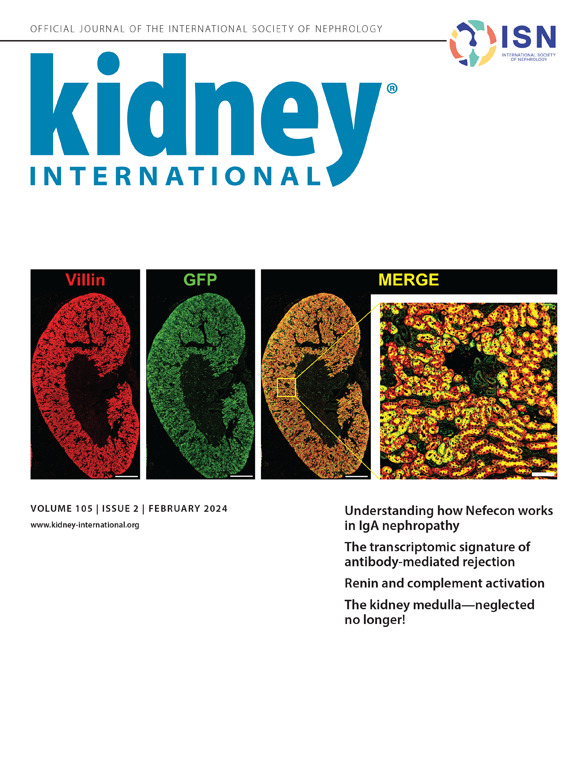A sub-study of the POISE-3 randomized trial examined effects of a perioperative hypotension-avoidance strategy versus a hypertension-avoidance strategy on the risk of acute kidney injury
IF 12.6
1区 医学
Q1 UROLOGY & NEPHROLOGY
引用次数: 0
Abstract
In this pre-specified sub-study of the POISE-3 trial, we examined the effect of a perioperative hypotension-avoidance strategy versus a hypertension-avoidance strategy on the risk of postoperative acute kidney injury (AKI). Altogether, 7307 patients were included from 110 hospitals in 22 countries. Patients were 45 years and older, had or were at risk of atherosclerotic disease, took at least one antihypertensive medication, and were scheduled for noncardiac surgery. Hypotension-avoidance strategy: (i) target intraoperative mean arterial pressure (MAP) 80 mm Hg or over, (ii) on day of surgery and for two days after, hold renin-angiotensin-aldosterone system inhibitors and use other antihypertensives in stepwise fashion if systolic blood pressure (SBP) 130 mm Hg or more. Hypertension-avoidance strategy: (i) target intraoperative MAP 60 mm Hg or more, (ii) continue all antihypertensives before and after surgery. Primary outcome: postoperative AKI, an increase in serum creatinine concentration of either 26.5 μmol/L or more (0.3 mg/dL or more) within 48 hours of randomization or 50% or more within seven days of randomization. The hypotension-avoidance group (3654 patients) used fewer antihypertensive medications than the hypertension-avoidance group (3653 patients); specifically, 6% vs. 38% used an ACEI or ARB on the day of surgery, and 6% vs. 47% and 7% vs. 50% one and two days after surgery, respectively. Patients also spent about half as much intraoperative time with a MAP under 80 mm Hg (27 vs. 60 minutes, respectively), but had little difference in average BP before or after surgery. There was no significant difference in AKI risk (15.1% vs. 14.4%). Results were consistent with other definitions of AKI and in patients with preexisting chronic kidney disease. Thus, a hypotension-avoidance strategy targeting a MAP greater than 80 mm Hg in the operating room and discontinued blood pressure medication during the perioperative period did not confer a lower risk of AKI compared to a hypertension avoidance strategy.
Clinical trial registration number: NCT03505723

POISE-3 随机试验的一项子研究考察了围术期避免低血压策略与避免高血压策略对急性肾损伤风险的影响。
在这项 POISE-3 试验的预设子研究中,我们考察了围手术期避免低血压策略与避免高血压策略对术后急性肾损伤(AKI)风险的影响。该研究共纳入了来自 22 个国家 110 家医院的 7307 名患者。患者年龄在45岁及以上,患有或有可能患有动脉粥样硬化疾病,至少服用一种降压药,并计划接受非心脏手术。避免高血压策略:(i) 以术中平均动脉压 (MAP) 80 毫米汞柱或以上为目标,(ii) 在手术当天及术后两天内服用肾素-血管紧张素-醛固酮系统抑制剂,如果收缩压 (SBP) 130 毫米汞柱或以上,则逐步使用其他降压药。避免高血压策略:(i) 术中目标血压为 60 毫米汞柱或以上,(ii) 手术前后继续使用所有降压药。主要结果:术后 AKI,即随机分组后 48 小时内血清肌酐浓度增加 26.5 μmol/L 或以上(0.3 mg/dL 或以上),或随机分组后 7 天内血清肌酐浓度增加 50%或以上。避免低血压组(3654 名患者)使用的降压药少于避免高血压组(3653 名患者);具体而言,手术当天使用 ACEI 或 ARB 的患者分别为 6% 对 38%,手术后 1 天和 2 天使用 ACEI 或 ARB 的患者分别为 6% 对 47% 和 7% 对 50%。患者术中血压低于 80 mm Hg 的时间也只有术前的一半(分别为 27 分钟和 60 分钟),但术前和术后的平均血压差异不大。AKI 风险没有明显差异(15.1% 对 14.4%)。结果与其他 AKI 定义一致,也与已有慢性肾病的患者一致。因此,与避免高血压的策略相比,以手术室内血压大于 80 mm Hg 为目标的避免低血压策略和围手术期停用降压药并不能降低 AKI 风险。
本文章由计算机程序翻译,如有差异,请以英文原文为准。
求助全文
约1分钟内获得全文
求助全文
来源期刊

Kidney international
医学-泌尿学与肾脏学
CiteScore
23.30
自引率
3.10%
发文量
490
审稿时长
3-6 weeks
期刊介绍:
Kidney International (KI), the official journal of the International Society of Nephrology, is led by Dr. Pierre Ronco (Paris, France) and stands as one of nephrology's most cited and esteemed publications worldwide.
KI provides exceptional benefits for both readers and authors, featuring highly cited original articles, focused reviews, cutting-edge imaging techniques, and lively discussions on controversial topics.
The journal is dedicated to kidney research, serving researchers, clinical investigators, and practicing nephrologists.
 求助内容:
求助内容: 应助结果提醒方式:
应助结果提醒方式:


